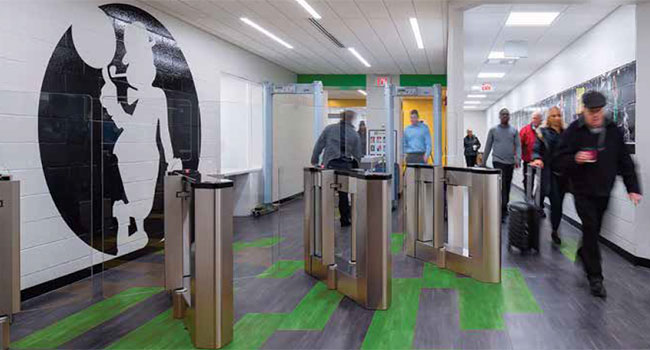
Solid on the Ground
Engineers collaborate on access control ideas to keep the gates open
- By Ralph C. Jensen
- May 01, 2018
Talk about intensity, Aeroturn engineers have found
a new passion for developing turnstiles. In fact, they
treat everything they do as if it is the only thing they
do. They take great pride in manufacturing a “Made in
the USA” access control device.
“We have a lot of passion,” said Michael Stoll, vice president of
technical sales and marketing at Aeroturn LLC. “We pride ourselves
in manufacturing a superb product in Connecticut, for security in the
United States.”
Their small-town USA story is equally as interesting. They are a
group of engineers who met and worked together in the 1980s, each
engineering products for other manufacturers. Perhaps over a cup of
morning coffee, each engineer determined they might be better off
collaborating, designing and earning patents as a team. And so Aeroturn
LLC was born.
“Several patents later, turnstiles found us,” Stoll said. “In the
1990s, we built more than 3,000 turnstiles for a customer, and we
enjoyed doing it. So, we went off on our own and created This Century’s
Turnstiles.
“We literally started with a clean sheet of paper, and thousands
of hours of development. We finally incorporated in 2001 and then
embarked on invention and testing.”
Aeroturn’s first rotary and linear turnstiles were installed in 2004,
and now they have a Who’s Who customer list, all of which is 100
percent repeat business, Stoll said. The list includes the Uniformed
Division of the U.S. Secret Service and the 18 acres of land the White
House sits on. Recent customers include the U.S. Treasury Department,
Harvard University and the renovation of the Baker Library,
which was built in the 1800s.
The company started with a three person strong staff, but has
grown quickly as projects have been secured and upgrades and renovations
have taken place. Stoll said it is not a fair fight when asked
about competition even though others have size and marketing tools
available to them. Stoll said because they are a small organization,
they are nimble enough to out maneuver the competition.
“In the past 15 years, we’ve never had a single lane replacement,”
Stoll said. “We pack in quality. All our parts and labor are in the
United States. We do a lot of different things from a launch and learn
to take things apart to see how we can improve upon them.
“We feel like we’re always on the leading edge, so it’s not a fair
fight with our competitors. The turnstile industry is a tough industry
to be involved in. Sometimes, it feels like it’s a race to the bottom.
That’s why we are pressing for the integration of biometrics on the
turnstile, the optical barcode and any customization that would work
for our customers.”
Aeroturn spends about 40 percent of its time in the federal government
space, and 25 percent each in the Class A tenant space and
pharmacy. Stoll said another 25 percent of their business is a rip and
replace activity where they have replaced a current turnstile design
that helps a new customer control access. The remaining 10 percent
is spent on campuses.
Once the equipment is properly specified, manufactured, and
delivered, Aeroturn technicians will perform the ultimate installation,
and then commission it. They use tile coring and drill equipment
of their own design, turnstile transport and positioning tools
developed by Aeroturn for Aeroturn, and anchorage techniques
developed for turnstiles to efficiently produce
results superior to any other method of installing
turnstiles. We even make available our own
proprietary cable for interconnects and desk
control hookup.
Photograph by William Horne
This article originally appeared in the May 2018 issue of Security Today.
About the Author
Ralph C. Jensen is the Publisher/Editor in chief of Security Today magazine.